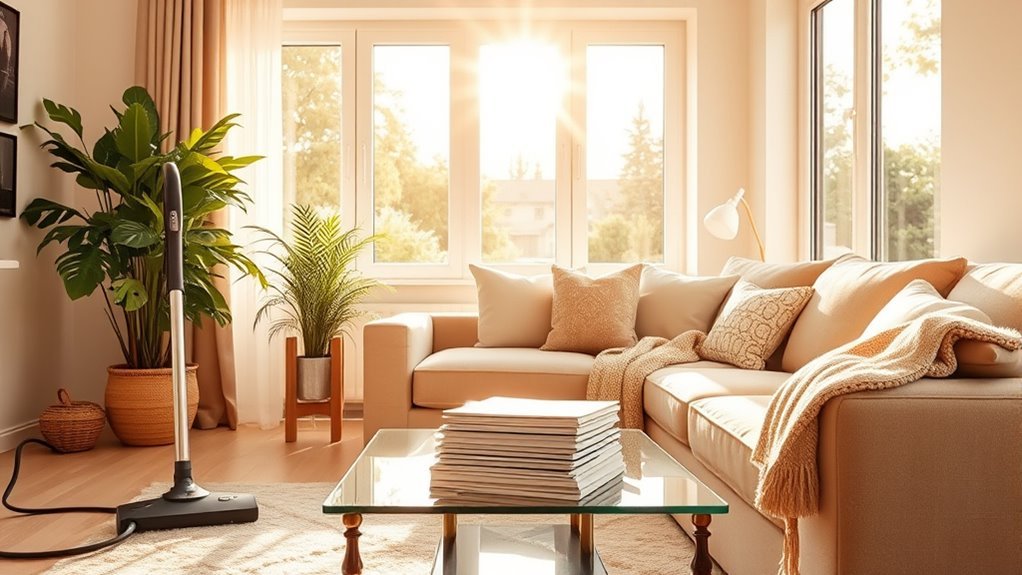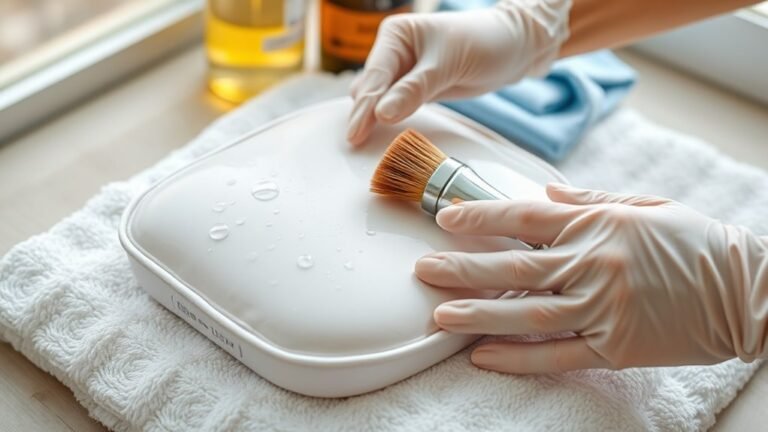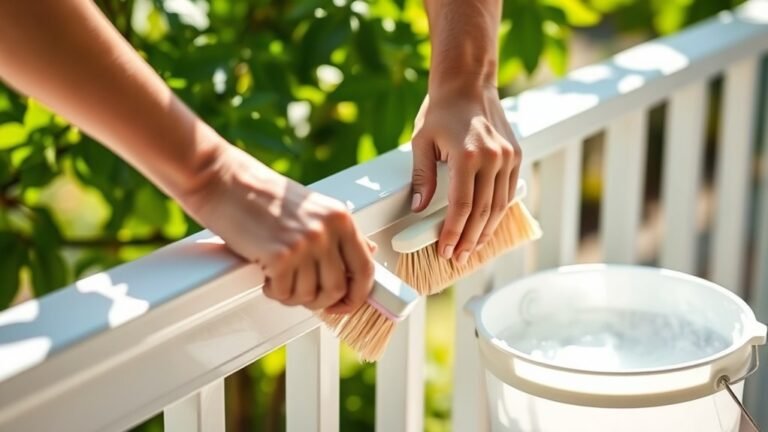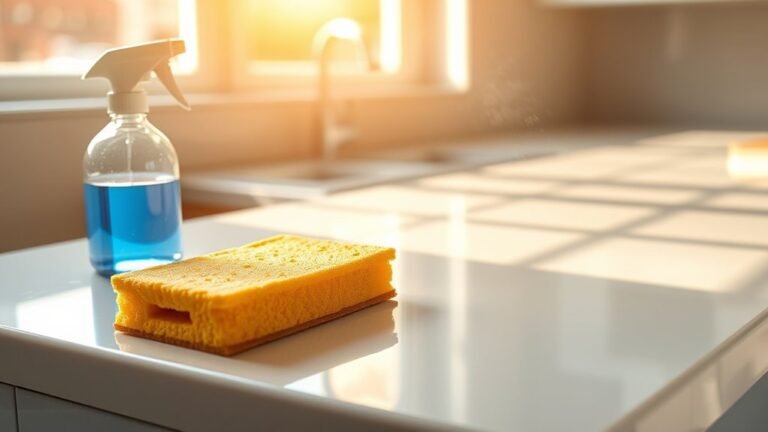How to Clean Your Living Room in 10 Minutes
Start by gathering your cleaning supplies like a microfiber cloth, multipurpose cleaner, and a duster in a portable caddy for easy access. Quickly declutter your main surfaces and floors, sorting items to keep or relocate. Dust furniture and electronics carefully, then fluff cushions to maintain their shape. Wipe down glass and mirrors using a microfiber cloth and appropriate cleaner. Finish by vacuuming or sweeping the floor thoroughly. Mastering this methodical process makes a fast, efficient living room refresh possible. Explore further for detailed tips.
Gather Your Cleaning Supplies
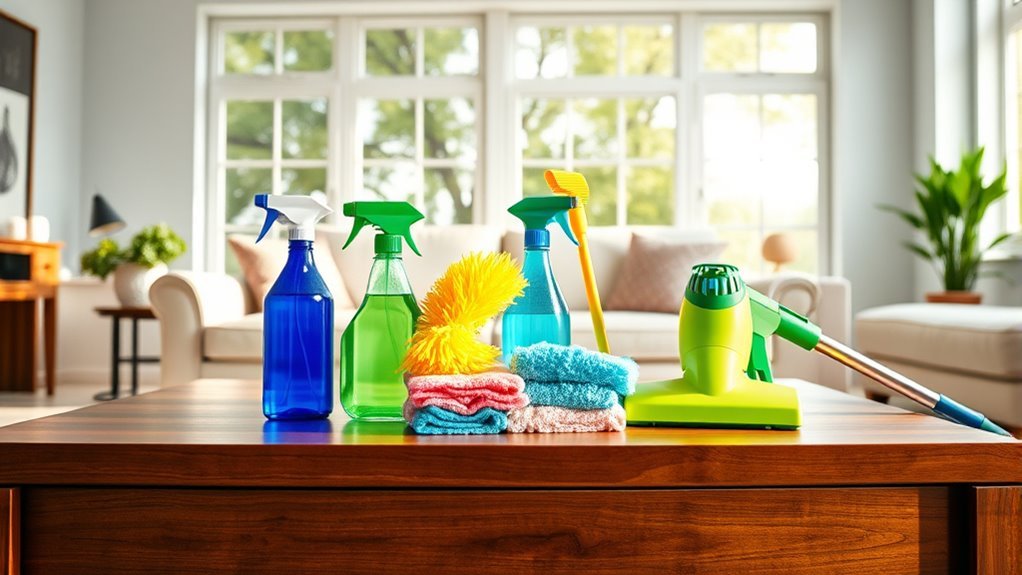
Before you begin cleaning, make sure you’ve gathered all necessary supplies to avoid interruptions. Start with essential tools: microfiber cloths, a multipurpose cleaner, a duster, and a small handheld vacuum or brush. These items streamline your process and save valuable time. Incorporate cleaning hacks like using a lint roller for fabric surfaces or a dampened cloth for dusting delicate electronics. Keep your supplies in a portable caddy to move freely around the room, maintaining momentum. Having everything at hand lets you work efficiently without wasting energy searching for products. By preparing thoughtfully, you’ll free yourself from distractions and complete your task swiftly, enjoying a clean living space without hassle. This approach respects your desire for freedom and maximizes results within minutes. Additionally, using microfiber cloths regularly helps prevent scratches and improves dust removal efficiency.
Declutter Surfaces and Floors
Start by clearing off at least three main surfaces—coffee table, side tables, and any shelves—and the floor area. Use simple decluttering strategies: gather all items that don’t belong or create visual clutter and sort them quickly into ‘keep,’ ‘relocate,’ or ‘discard’ piles. Focus on surface organization by grouping similar items and placing frequently used objects within easy reach. Clear the floor by picking up toys, magazines, or shoes, returning them to their proper spots or storage bins. This step maximizes your living room’s open space and creates a sense of freedom from chaos. Stick to this methodical approach to maintain control over your environment. Efficient decluttering not only refreshes your room but also sets the stage for faster cleaning in the next steps.
Dust Furniture and Electronics
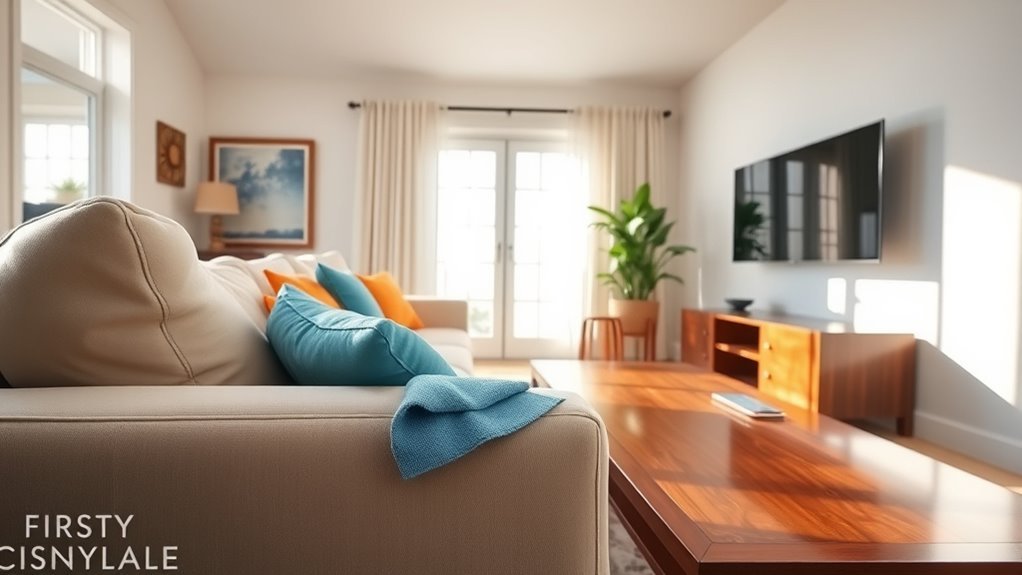
A microfiber cloth is your best tool for dusting furniture and electronics efficiently. Begin by lightly wiping all surfaces, including shelves, tables, and TV stands, to lift dust without scratching. For wooden furniture, apply a small amount of furniture polish to the cloth rather than directly on surfaces, enhancing shine and protection. When it comes to electronics, use electronic wipes designed specifically for screens and devices to avoid damage. Gently clean remote controls, keyboards, and screens, ensuring no moisture seeps into openings. Move methodically from top to bottom, paying attention to corners and crevices where dust accumulates. This approach frees you from lingering dust and maintains your living room’s fresh, polished look, all within minutes. Using the right supplies is essential, so always gather the right cleaning supplies before starting to ensure efficient and safe cleaning.
Clean and Fluff Cushions and Pillows
Start by removing your cushions and pillows, giving them a good shake to loosen dust and debris. Check for any stains and spot clean them promptly to prevent setting. Finally, fluff each piece thoroughly and rotate them to maintain even wear. Regular vacuuming removes dust and debris to keep your sofa fresh longer.
Remove and Shake
Two quick shakes can instantly refresh your cushions and pillows. Start by removing them from your sofa or chairs, setting them aside temporarily. Take each cushion and pillow outside or to an open window, then give them a firm shake to dislodge dust and debris. This simple step mimics the effect of shaking rugs, allowing trapped particles to escape. While you’re at it, use this moment to remove clutter around your living room, clearing surfaces and floors for a neat environment. Once shaken, fluff each item by kneading and patting to restore shape and comfort. Return the cushions and pillows neatly to their spots. This focused routine not only revitalizes your seating but also creates a sense of freedom through a clean, clutter-free living space.
Spot Clean Stains
Several quick steps can help you effectively spot clean stains on your cushions and pillows. First, identify the fabric type to choose the right stain removal techniques—check care labels for specific instructions. Blot fresh stains gently with a clean cloth to avoid spreading. Apply a small amount of mild detergent mixed with water, testing it on an inconspicuous area to verify colorfastness. Use a soft-bristled brush or cloth to work the solution into the stain carefully. Rinse the area sparingly with water, then blot excess moisture. Avoid overwetting to prevent fabric damage. Once cleaned, let cushions and pillows air dry thoroughly. Proper fabric care during spot cleaning keeps your living room fresh without compromising your freedom to relax and enjoy your space.
Fluff and Rotate
One essential step in maintaining your cushions and pillows is to fluff and rotate them regularly. Start by removing each pillow and cushion from your sofa or chairs. To fluff pillows, grasp them firmly and give them a few sharp, quick pats to redistribute the filling evenly. This restores their shape and comfort. Next, rotate cushions by turning them end to end or flipping them over. This prevents uneven wear and helps maintain their form. Pay attention to corners and seams, ensuring they’re not compressed or misshaped. Doing this routine every week keeps your living room furniture looking fresh and inviting without extra effort. Fluff pillows and rotate cushions consistently, and you’ll extend their lifespan while enjoying a tidier, more comfortable space.
Wipe Down Glass and Mirrors
Glass surfaces and mirrors can quickly accumulate fingerprints, dust, and smudges that dull their appearance. To keep them sparkling in no time, follow these glass cleaner tips for effective mirror maintenance:
- Spray a small amount of glass cleaner onto a microfiber cloth instead of directly on the surface to avoid streaks.
- Wipe in a circular motion, then finish with vertical strokes for a streak-free shine.
- Pay special attention to edges and corners where grime tends to build up.
- Use a dry, lint-free cloth to buff the surface once cleaned.
- For an eco-friendly option, consider using a vinegar and water mix as a natural cleaning solution.
Vacuum or Sweep the Floor
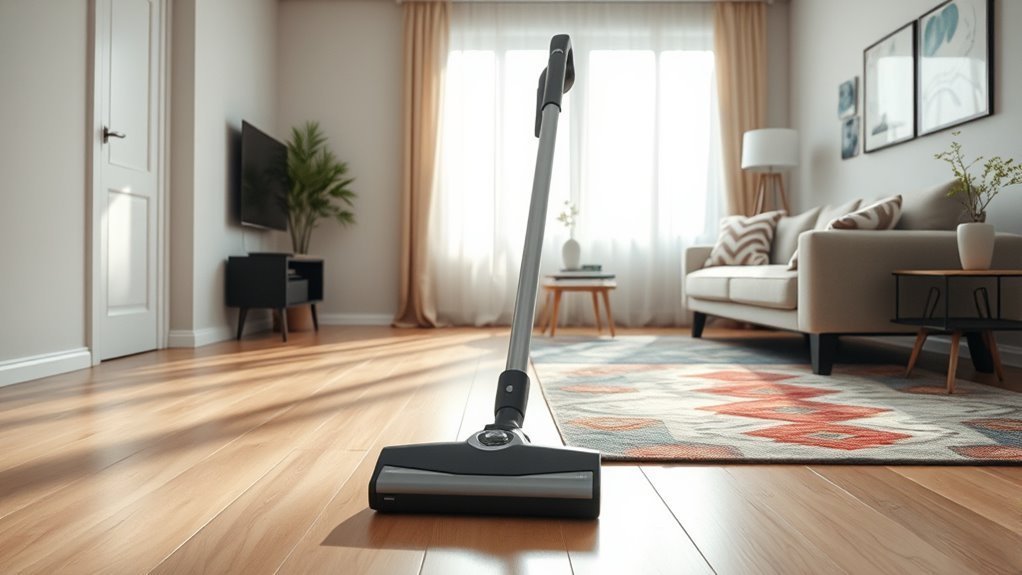
Start by choosing the right tool—vacuum for carpets and sweep for hard floors. Clear any obstacles to guarantee you can clean efficiently without stopping. Focus on high-traffic areas where dirt and debris tend to accumulate the most.
Choose the Right Tool
Selecting the right tool for your floor type can save you time and effort. When deciding between vacuuming or sweeping, consider your living room’s surface and the cleaning tools you have available. Using effective equipment tailored to your floor guarantees a quicker, thorough job. Here’s how to choose:
- For carpeted floors, opt for a vacuum with strong suction to pull dirt from deep fibers.
- Hard floors like wood or tile benefit from a broom or a vacuum with a hard floor setting.
- Use a vacuum with attachments for corners and edges to capture hidden dust.
- Lightweight, cordless vacuums offer freedom of movement and speed during quick cleanups.
Picking the right tool aligns your effort with results, freeing up time to enjoy your refreshed space.
Focus on High-Traffic Areas
Although it might be tempting to clean the entire floor, focusing on high-traffic areas will give you the most noticeable results in less time. Identify the high traffic pathways—usually the spaces between your main furniture pieces and near entrance points. Concentrate your vacuuming or sweeping efforts there, where dirt and debris accumulate fastest. Pay attention to your furniture arrangement; areas around sofas, coffee tables, and chairs often collect dust and crumbs. Move methodically along these zones to capture hidden dirt. This targeted approach maximizes efficiency, freeing you to enjoy your clean living room sooner. By prioritizing these key spots, you maintain a tidy space without wasting time on seldom-used corners. Stick to this strategy regularly, and your living room will stay fresh with minimal effort.
Clear Obstacles First
Once you’ve targeted the high-traffic spots, the next step is to clear any obstacles that could slow down your cleaning. Efficient obstacle removal not only speeds up the process but also improves space organization, making your living room feel more open and inviting. Start by quickly picking up items that clutter the floor, then focus on these key tasks:
- Move small furniture or objects blocking your vacuum or broom path.
- Gather loose cables or rugs that could snag your cleaning tools.
- Collect toys, magazines, and other stray items into a bin or basket.
- Sweep or vacuum the entire floor surface methodically, ensuring no dust or dirt remains.
Frequently Asked Questions
What Cleaning Supplies Are Best for Pet Hair Removal?
Tackling pet hair feels like chasing shadows, but you’ve got the right tools. Start with vacuum cleaners boasting strong suction and pet-specific attachments to lift hair from carpets and upholstery. Follow up with lint rollers for quick touch-ups on clothes and cushions. These supplies are your freedom fighters against fur, letting you reclaim a clean space swiftly and efficiently without getting bogged down in endless cleaning battles.
How Often Should I Deep Clean My Living Room?
You should aim to deep clean your living room every few months to maintain a fresh space. Weekly maintenance keeps dirt and clutter at bay, making deep cleaning less intimidating. Consider a seasonal refresh—spring and fall are perfect times to tackle thorough cleaning tasks like shampooing carpets, washing curtains, and dusting hard-to-reach spots. This methodical routine frees you from constant upkeep stress, letting you enjoy a clean, inviting living room with minimal hassle.
Can I Use Natural Products for Dusting Furniture?
Dusting your furniture with natural products is like giving your living room a surge of revitalizing, clean air. You can mix a vinegar solution with water for an effective, streak-free clean. Adding a few drops of essential oils like lavender or lemon not only boosts the scent but also enhances antibacterial power. This method is gentle on surfaces, freeing you from harsh chemicals and letting your home shine naturally and safely.
What’S the Best Way to Remove Stains From Cushions?
For effective cushion cleaning and stain removal, start by blotting the stain gently with a clean cloth to avoid spreading it. Mix mild detergent with water, then dab the solution onto the stain using a sponge. Avoid soaking the cushion. Let it sit for a few minutes, then blot again with a dry cloth. For stubborn stains, a mixture of vinegar and baking soda works wonders. Always air dry cushions fully to prevent mildew.
How Do I Keep Electronics From Getting Dusty Quickly?
To keep your electronics from getting dusty quickly, use electronic covers whenever possible—they act as a barrier against dust buildup. Make regular maintenance a habit by wiping devices with a microfiber cloth at least once a week. Also, keep your living space well-ventilated and avoid placing electronics near open windows or vents. These simple steps help you maintain freedom from constant cleaning and keep your devices performing at their best.
